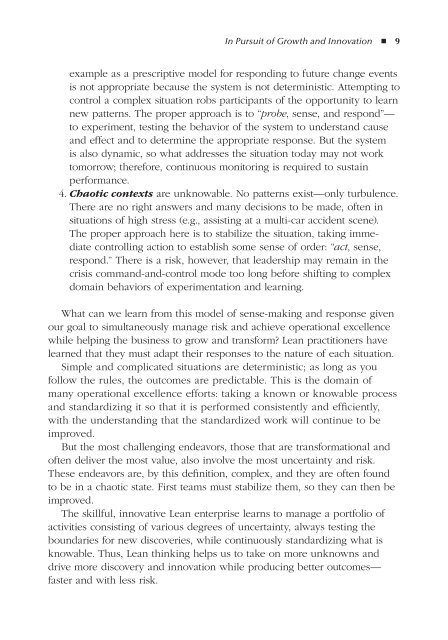Run-Grow-Transform-Chapter-One-distribute-freely
Run-Grow-Transform-Chapter-One-distribute-freely
Run-Grow-Transform-Chapter-One-distribute-freely
You also want an ePaper? Increase the reach of your titles
YUMPU automatically turns print PDFs into web optimized ePapers that Google loves.
In Pursuit of <strong>Grow</strong>th and Innovation ◾ 9<br />
example as a prescriptive model for responding to future change events<br />
is not appropriate because the system is not deterministic. Attempting to<br />
control a complex situation robs participants of the opportunity to learn<br />
new patterns. The proper approach is to “probe, sense, and respond”—<br />
to experiment, testing the behavior of the system to understand cause<br />
and effect and to determine the appropriate response. But the system<br />
is also dynamic, so what addresses the situation today may not work<br />
tomorrow; therefore, continuous monitoring is required to sustain<br />
performance.<br />
4. Chaotic contexts are unknowable. No patterns exist—only turbulence.<br />
There are no right answers and many decisions to be made, often in<br />
situations of high stress (e.g., assisting at a multi-car accident scene).<br />
The proper approach here is to stabilize the situation, taking immediate<br />
controlling action to establish some sense of order: “act, sense,<br />
respond.” There is a risk, however, that leadership may remain in the<br />
crisis command-and-control mode too long before shifting to complex<br />
domain behaviors of experimentation and learning.<br />
What can we learn from this model of sense-making and response given<br />
our goal to simultaneously manage risk and achieve operational excellence<br />
while helping the business to grow and transform? Lean practitioners have<br />
learned that they must adapt their responses to the nature of each situation.<br />
Simple and complicated situations are deterministic; as long as you<br />
follow the rules, the outcomes are predictable. This is the domain of<br />
many operational excellence efforts: taking a known or knowable process<br />
and standardizing it so that it is performed consistently and efficiently,<br />
with the understanding that the standardized work will continue to be<br />
improved.<br />
But the most challenging endeavors, those that are transformational and<br />
often deliver the most value, also involve the most uncertainty and risk.<br />
These endeavors are, by this definition, complex, and they are often found<br />
to be in a chaotic state. First teams must stabilize them, so they can then be<br />
improved.<br />
The skillful, innovative Lean enterprise learns to manage a portfolio of<br />
activities consisting of various degrees of uncertainty, always testing the<br />
boundaries for new discoveries, while continuously standardizing what is<br />
knowable. Thus, Lean thinking helps us to take on more unknowns and<br />
drive more discovery and innovation while producing better outcomes—<br />
faster and with less risk.<br />
TAF-K14527-12-0302-C001.indd 9<br />
13/08/12 8:25 PM


